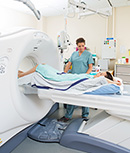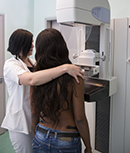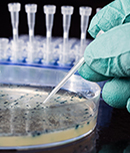Research Highlights

|
Clinical Trial Helps Avoid Unnecessary Surgery The PET-NECK clinical trial has shown that using PET-CT scans for surveillance can better target surgery. |
No decline over time when reading mammograms A new study has found there is no decline over time in the accuracy of medical staff who analyse mammogram scans. |
|
No decline over time when reading mammogramsA new study has found there is no decline over time in the accuracy of medical staff who analyse mammogram scans for indications of breast cancer. The research was conducted by Dr Sian Taylor-Phillips who was funded by an NIHR Doctoral Research Fellowship. Dr Taylor-Phillips examined whether a phenomenon called ‘the vigilance decrement’ would apply in which accuracy of repetitive tasks decreases over time. Breast x-rays or mammograms show lots of overlapping tissue and cancers can be quite difficult to spot. To the research team’s surprise they found that the cancer detection rates throughout each batch of approximately 35 readings didn’t change. They had expected accuracy to decline towards the end of each batch. Dr Taylor-Phillips said: “We found no reduction in performance or vigilance decrement at all. In fact, we found the opposite of what we were expecting - breast screening readers seemed to get ‘into the zone’ and their performance improved with time on task. They recalled fewer women for further tests as they got nearer the end of the batch while cancer detection rates stayed constant.” In the UK National Health Service Breast Screening Programme two readers separately examine each woman’s mammograms for signs of cancer. Women have mammograms taken of both breasts and these are examined for signs of cancer by trained staff. Both readers scrutinise batches of around 35 women’s mammograms. Current practice is that both readers examine the x-rays in the same order as one another, so if they both experience a vigilance decrement, the vigilance will be low for both readers when examining the same women’s mammograms. To test the vigilance decrement theory the researchers changed the case order for the two readers expecting them to experience low vigilance when examining different women’s mammograms. A real-world randomised controlled study in UK clinical practice was conducted incorporating 1.2 million women’s x-rays in the trial. As well as finding no effect on cancer detection rate, in an exploratory post-hoc analysis, they found that their overall performance improved with time on task. Whilst the readers kept up a constant rate of detecting cancer, the number of women they recalled for further tests to achieve this decreased over time. When readers first sat down and started the task they recalled on average 6.4 women per thousand screened, this decreased to 4.6 per thousand screened after examining 40 women’s mammograms in a row. Dr Taylor-Phillips said: “Psychologists have been investigating a phenomenon of a drop in performance with time on a task called ‘the vigilance decrement’ since World War 2. In those days radar operators searched for enemy aircraft and submarines which appeared as little dots of light on a radar screen. “People thought that the ability to spot the dots might go down after too much time spent on the task. Many psychology experiments have found a vigilance decrement, but most of this research has not been in a real world setting, unlike our study.” Dr Taylor-Phillips and her team are going to expand their research in this area. They are currently analysing how performance changes over longer reading sessions, and whether examining mammograms at different times of day affects performance. |
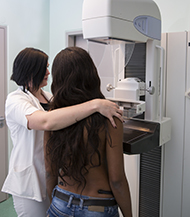
|
Pandora's Box: Bringing Together Art and ResearchA new sculptural installation in the Science Museum’s ‘Who Am I?’ gallery explores the potential issues raised by the expansion of genetic screening. Pandora’s Box is the result of a collaboration between the artist, Esther Fox, and WMS researcher, Dr Felicity Boardman. Felicity’s project, Imagining Futures, investigated the social and ethical implications of expanding genetic screening programmes, specifically related to the genetic condition Spinal Muscular Atrophy (SMA). Felicity interviewed families living with SMA and from there developed a survey which was completed by 337 participants, either adults living with SMA or family members. Living with SMA herself, Esther contacted Felicity when she saw the project advertised. Esther has long had an interest in genetics and disability which she has explored through her art since art school. The issues explored through the Imagining Futures project resonated with Esther’s personal interests, leading to a collaborative relationship. Pandora’s Box is a change from her previous painting and two dimensional work. The box is made from lead embossed with text about the value of life and a large double helix escapes it, made from computer punch tape. Behind the box, you can see excerpts from the research interviews. In an interview with Culture 24, Esther stated that she hopes “the piece will encourage the public to question preconceptions about the value of disabled people’s lives and enable a more expansive idea about what it means to be human.” Weaving together art and research, this collaboration opens up the discussion about disability, medical ethics and health research in general, to a whole new audience. Felicity says: "Esther’s sculpture, Pandora’s Box, offers viewers a chance to engage with the themes of the Imagining Futures Research Project in a very visceral way. The materials she uses, combined with the research data, brings together both the abstract and the immediate: the perspectives of people living with genetic disease on genetic screening, with the broader themes of reductionism and selection that pervade many of the surrounding debates. Ultimately, the installation is a reflection on what it means to be human in a society in which screening is becoming increasingly commonplace." |

"I am not disabled by my genetic condition" Esther Fox on the Pandora's Box of screening for disability (Culture 24) Who Am I? Gallery at the Science Museum "Should we edit out genetic disease?" by Dr Felicity Boardman (The Conversation) |
Clinical Trial Helps Avoid Unnecessary SurgeryHead and neck cancer (HNC) and its treatment has devastating effects on patients’ self-image, speech and swallowing. After chemoradiotherapy, remaining cancer cells can be difficult to identify, meaning that patients often have to undergo go a three-hour neck dissection surgery. Neck dissection surgery can have significant complications and after-effects, such as shoulder movement disability, disfigurement of the mouth and neck, and long-term pain. The surgery means up to a week in hospital and has considerable morbidity. The PET-NECK clinical trial has shown that using positron emission tomography-computed tomography (PET-CT) scans for image-guided surveillance means that these routine operations were no longer necessary, and can now be better targeted for the 20% of patients who still have persistent cancer. The study was conducted across 37 centres in the UK, co-ordinated by Warwick Clinical Trials Unit and sponsored by University Hospitals Coventry and Warwickshire. 564 patients were recruited between 2007 and 2012, with 282 in the image-guided surveillance group and 282 in the neck dissection control group. Only 54 (19%) in the image-guided surveillance group went on to undergo neck dissection surgery, compared with 221 (78%) in the control group. Survival rates, quality of life and other factors were considered and remained similar across both groups. Professor Janet Dunn, from Warwick Clinical Trials Unit said: “This is an important study for the future management of these patients. When we first designed the study in 2007, patients were undergoing routine neck dissection and they did not have access to PET-CT. The results show that the use of PET-CT imaging can prevent unnecessary operations and reduce associated surgical complications.” As well as the improvement to patient outcomes and avoiding unnecessary surgeries, the PET-CT guided surveillance saved £1,492 per person for the NHS. With around 2,000 patients in the UK each year and up to 100,000 cases world-wide, there’s a significant saving, freeing up funding for other therapies. |
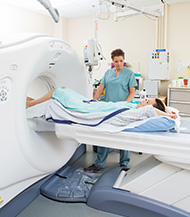
WMS PI: Janet Dunn |
Identifying genetic risks for oesophageal cancerBarrett’s esophagus (BE) is a very common premalignant lesion affecting up to 2-3% of the Western population. BE increases the risk for esophageal adenocarcinoma (EAC). This cancer is unfortunately all too commonly detected past the point where it can be completely cured. Therefore it is important to develop new strategies for earlier detection. In addition, these patients may have a higher chance of developing ischaemic heart disease. An increased risk for BE has been associated with single nucleotide polymorphisms (SNPs) on particular chromosomes. Researchers at UHCW and WMS have performed a genome-wide association study to identify SNPs that increase risk for BE and validate previously reported associations. The research identified two loci (positions on the chromosome) associated with risk for BE. It also supports a locus previously associated with risk in the BEACON gene (linked to obesity and type 1 diabetes). The genes found to be associated with risk for BE are involved in thoracic, diaphragmatic, and oesophageal development. This is the largest study ever in BE research. It represents a further advance in identifying genetic predisposition for BE. This allows the risk to be mitigated through interventions such as lifestyle changes or drugs relevant to cancer and heart disease. |

WMS PI: Janusz Jankowski Key Paper: Polymorphisms Near TBX5 and GDF7 Are Associated With Increased Risk for Barrett’s Esophagus (on ResearchGate.net) |
The drugs don’t workBacteria are excellent accessible sources of diverse biologically active small drug-like molecules. These “Natural Products” have provided mankind with many important drugs including:
Unfortunately the extensive and often inappropriate use of many current drugs has driven the evolution of infectious agents and pests that are now resistant to these treatments. The desperate need for novel compounds to augment or replace these failing treatments has been widely publicised and needs little elaboration here. So where do we find the next generation of drugs? Genomic analysis has revealed that many bacteria encode a large diversity of genes dedicated to the synthesis of Natural Products. They typically fulfil niche specific roles and can have a diverse range of biological activities. Furthermore, given that they are being maintained by natural selection it follows that every one of them has a biological activity, unlike the majority of molecules in synthetic compound libraries used by Pharma. The task at hand therefore is to devise methodology that will enable us to move from the identification of Natural Product synthetic gene clusters in bacterial genome sequences toward the identification of the Natural Product structure and biological activity. A reduction in the cost of DNA sequencing and advances in synthetic biology techniques such as chromosomal recombineering have now facilitated a rational and achievable approach to do just this. Historically soil bacteria such as Streptomyces have been the source of over two thirds of clinically useful antibiotics. However in order to find new drugs with biological activities relevant to a wider range of eukaryotic targets, such as anti-parastics, immune modulators, anti-cancer agents and even insecticides, it makes sense to look within the genomes of animal pathogens. Photorhabdus asymbiotica is a dual insect and human pathogen that exists in the soil in a symbiotic partnership with an insect parasitic nematode. Like other members of the genus it can produce a large range NPs with diverse biological roles. These activities include; killing competing prokaryotic and eukaryotic microbes, killing the insect host, “corpse-defence” against other scavenging metazoans and manipulation of the immune system of its insect (or human) host. These properties make these insect pathogens a goldmine for drug discovery. Using a combination of genomics and biological chemistry we have been able to identify literally hundreds of new compounds from these insect pathogens facilitated by an EU 7th framework consortium grant called GAMEXP. We are now engaged with the challenging process of identifying biological roles for many of these promising molecules. Our most recent work describes the synthesis of what we have called the “GameXPeptide”. Importantly we have shown that the molecule made in the insect host is different from that made in normal lab culture. This has important implications for future drug discovery efforts. Finally, these molecules may prove very valuable as they show apparent specific toxicity towards the malaria parasite Plasmodium. |

|
Warwick-Edinburgh Mental Health and Well-being Scale (WEMWBS)The Warwick-Edinburgh Mental Well-being scale was developed to enable the monitoring of mental wellbeing in the general population and the evaluation of projects, programmes and policies which aim to improve mental wellbeing. WEMWBS is a 14 item scale with 5 response categories, summed to provide a single score ranging from 14-70. The items are all worded positively and cover both feeling and functioning aspects of mental wellbeing. The WEMWBS has been translated into a number of languages and some of these have been validated both psychometrically and qualitatively. Some of the translated versions are available to download from the website and others are available from the authors. Greek, French, German, Lithuanian and Hindi versions and the short version in Chinese, short version in Japanese and short version in Finnish are available to download from the website and Spanish and Dutch versions are available online. Validations of versions in Bangla and Urdu have also been completed and are being prepared for publication. WEWMBS has been disseminated widely to stakeholders, including nationally in the ONS measuring wellbeing debate, in the NHS Futures Forum, and internationally at the World Mental Health Promotion Conferences in Washington DC and Perth, Australia. Dissemination has been further enabled by presence on mental health policy groups including:
As a result, WEMWBS has been adopted by the English and Scottish Governments as part of their health outcomes frameworks against which the NHS’ and Public Health Services’ effectiveness will be monitored. Internationally WEMWBS was selected by the Icelandic Government to monitor population mental health. The Public Health Transitions Team at the Department of Health has identified public mental health as one of five priority areas for action. |

|
Fertility calculatorA new mathematical method can help to predict a couple’s chances of becoming pregnant, according to how long they have been trying. The model may also shed light on how long they should wait before seeking medical help. For example, the researchers have found that, if the woman is aged 35, after just six months of trying, her chance of getting pregnant in the next cycle is then less than 10 per cent. Researchers at WMS collaborated with the London School of Economics to develop the analysis, which uses the number of menstrual cycles over which the couple has been trying for a baby to detemine a probability of conception within the next month. A common rule of thumb is that couples should try having regular sex for a year before seeking help. But the new research shows that age also has a bearing on this decision. When a woman is 25, it takes 13 menstrual periods before her chance of pregnancy in each new cycle has declined to below 10 per cent, according to the model. The number of months required to reach a conception chance below 10 per cent per cycle is 10 at age 30, and just six at age 35. Professor Geraldine Hartshorne of Warwick Medical School said: “Many couples are not aware that chance plays a big role in getting pregnant. People expect to get pregnant when they want to, so finding out that it isn’t happening can be a shock. Approaching a doctor about such a personal matter is daunting so knowing when is the right time to start investigations would be a useful step forward. “We can’t work out exactly when, or if, a woman will become pregnant – but this analysis can predict her chances, and give a percentage estimate of pregnancy in the next cycle.” Dr Peter Sozou of the London School of Economics said: “After several cycles without pregnancy, it becomes relatively more likely that a couple have low fertility. This is the main reason why it becomes less likely that conception will occur in the next cycle”. |

|
Imagining FuturesDevelopments in genetic medicine over the past 50 years have had a great impact on the number and nature of decisions to be made by prospective parents. In coming years, these decisions appear set to increase as the UK government considers the introduction of pre-conception and prenatal genetic screening. Imagining Futures is a research project that will explore the social and ethical implications of this screening, using the condition, Spinal Muscular Atrophy, as an example. Pre-conception and prenatal genetic screening involve the genetic testing of couples or pregnant women to see if they are carriers of a genetic disease. Previously, this testing was reserved only for people with a known history of genetic disease in their family, which means that they would usually be familiar with the effects of the condition. The introduction of genetic screening would mean that everyone could have tests to see if they are carriers of genetic conditions, either before conception or after a pregnancy is established. The general public would therefore need to make decisions about being screened for conditions that they may have never experienced or heard of. Families living with genetic conditions can offer unique insights into what it's like to live with the conditions that can be screened for: their attitudes to screening, and the way in which they make decisions about using such tests, can tell us a lot about how valuable 'experiential knowledge' is in reproductive decision making, and consequently help us to anticipate some potential issues that extending genetic screening programmes to those without such knowledge might bring. The Imagining Futures research project aims to understand the role and value of experiential knowledge in reproductive decision making by focusing on families living with spinal muscular atrophy. Spinal muscular atrophy is a condition that could be tested for if genetic screening were introduced. It is a neuromuscular condition causing varying degrees of muscle weakness. One in 40 people in the general population are estimated to be carriers of spinal muscular atrophy and there is no known cure or effective treatment so, if a pregnancy is found to be affected, termination is usually offered. Through narrative interviews with families living with spinal muscular atrophy, this project will explore the possible implications of the introduction of genetic screening. |

|
Tuberculosis genomes recovered from 200-year old Hungarian mummyResearchers at the University of Warwick have recovered tuberculosis (TB) genomes from the lung tissue of a 215-year old mummy using a technique known as metagenomics. The term ‘metagenomics’ is used to describe the open-ended sequencing of DNA from samples without the need for culture or target-specific amplification or enrichment. This approach avoids the complex and unreliable workflows associated with culture of bacteria or amplification of DNA and draws on the remarkable throughput and ease of use of modern sequencing approaches. The team, led by Professor Mark Pallen, Professor of Microbial Genomics at Warwick Medical School, working with Helen Donoghue at University College London and collaborators in Birmingham and Budapest, sought to use the technique to identify TB DNA in a historical specimen. The sample came from a Hungarian woman, Terézia Hausmann, who died aged 28 on 25 December 1797. Her mummified remains were recovered from a crypt in the town of Vác, Hungary. When the crypt was opened in 1994, it was found to contain the naturally mummified bodies of 242 people. Molecular analyses of the chest sample in a previous study confirmed the diagnosis of tuberculosis and hinted that TB DNA was extremely well preserved in her body. Professor Pallen explained the importance of the breakthrough: “Most other attempts to recover DNA sequences from historical or ancient samples have suffered from the risk of contamination, because they rely on amplification of DNA in the laboratory, plus they have required onerous optimisation of target-specific assays. “The beauty of metagenomics is that it provides a simple but highly informative, assumption-free, one-size-fits-all approach that works in a wide variety of contexts. A few months ago we showed that metagenomics allowed us to identify an E. coli outbreak strains from faecal samples, and a few weeks ago a similar approach was shown by another group to deliver a leprosy genome from historical material.” The research showed that Terézia Hausmann suffered from a mixed infection with two different strains of the TB bacterium. This information, combined with work on contemporary tuberculosis, highlights the significance of mixed-strain infections, particularly when tuberculosis is highly prevalent. Professor Pallen added: “It was fascinating to see the similarities between the TB genome sequences we recovered and the genome of a recent outbreak strain in Germany. It shows once more that using metagenomics can be remarkably effective in tracking the evolution and spread of microbes without the need for culture—in this case, metagenomes revealed that some strain lineages have been circulating in Europe for more than two centuries.” |
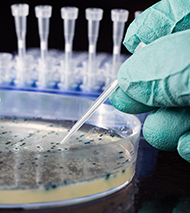
PI: Prof Mark Pallen |
Kirschner wires vs volar locking plateThe Distal Radius Acute Fracture Fixation Trial (DRAFFT) compared the outcomes of percutaneous fixation with Kirschner wires versus volar locking plate fixation int he treatment of adults with a dorsally displaced fracture of the distal radius. In the Western World, 6% of all women will have sustained a fracture of the wrist (distal radi-us) by the age of 80 and 9% by the age of 90 (this fracture is less common in men). Advances in orthopaedic surgery have improved the outcome for patients: many wrist fractures can be treated in a plaster cast alone, but others require surgical fixation to hold the bone in place while they heal. The existing evidence suggested that modern ‘locking-plate’ fixation provides improved wrist function but cost more than traditional ‘wire’ fixation. In this study, we randomly assigned 461 adult patients having surgery for a fracture of the dis-tal radius to either K-wire fixation or locking-plate fixation. The patients reported their own outcome in the 12 months after their fracture, using the Patient Rated Wrist Evaluation. We also collected information on complications and costs. Over 90% of the patients who took part completed the study. Both groups of patients recov-ered wrist function by 12 months, although their wrists were not quite back to normal. There was no difference between groups in their wrist function at 3 months, 6 months or 12 months. Nor was there a difference in the number of complications in each group. We did find that K-wire fixation is ‘cost saving’, particularly in younger patients. Contrary to the existing literature, and against the increasing use of plate fixation, this study shows that there is no difference between K-wires and locking-plates for patients with frac-tures of the distal radius. K-wire fixation is less expensive and quicker to perform. This trial was funded by the National Institute of Health Research for Health Technology Assessment (NIHR HTA) Programme. |

|
Current Evidence Does Not Support Selenium for Preventing Heart Disease in Well-Nourished AdultsA systematic review published in The Cochrane Library finds that in well-nourished adults, current evidence does not support selenium for preventing heart disease. The review suggests that taking selenium supplements does not reduce a person’s risk of developing heart disease, although most evidence is currently limited to healthy American adults. Diet is a key factor influencing heart disease risk. Selenium is one dietary element that could potentially play a role in preventing heart disease by protecting against oxidative stress and inflammation. It is a common food supplement and is often given to guard against heart disease, but with little evidence that it works. In addition, there is concern that consuming too much selenium could increase a person’s risk of type 2 diabetes in individuals with high selenium status. The researchers analysed data from 12 trials that together involved 19,715 people. Compared to placebos, taking selenium supplements did not lead to any statistically significant difference in the risk of death due to heart disease or any cause, or in the occurrence of heart problems. Although supplements were associated with a small increase in the risk of type 2 diabetes, this increase was not large enough to be statistically significant. Side effects included alopecia and dermatitis. One of the authors, Saverio Stranges (WMS), said “The limited evidence available at this time does not support the use of selenium supplements in the primary prevention of heart disease in well-nourished populations. Taking selenium supplements is probably neither beneficial nor harmful, but given the lack of trials to date, we cannot rule out some low level of increased risk of type 2 diabetes, at least in individuals with high selenium status.” Most current evidence on selenium and heart disease risk is limited to American adults who are already getting adequate levels of selenium in their daily diets. The trials the researchers reviewed involved healthy individuals rather than groups that might be predisposed to selenium deficiency. Dr Stranges continued: “We need to know what effect selenium supplements have in less well-nourished populations where dietary intake of the element is lower. However, the indiscriminate and widespread use of selenium supplements in individuals and populations with adequate or high selenium status is not justified and should not be encouraged.” This project was funded by the National Institute for Health Research Systematic Reviews Programme. |

Key Paper: Selenium supplementation for the primary prevention of cardiovascular disease (PubMed) |
The team of proteins that could have implications for the fight against cancerResearchers at Warwick Medical School have identified the key role played by a team of proteins in the process of mitosis. Working out how to control them may give scientists a way to destroy cancerous cells. The research highlights the role of a newly identified team of proteins, TACC3-ch-TOG-clathrin, in forming inter-microtubule bridges that stabilise the kinetochore fibres (K-fibres) used in mitosis. When a cell divides, it produces a mitotic spindle which then makes sure that the chromosomes are divided equally between the two new cells. Failure to do so efficiently can lead to problems; those cells with either too few or too many chromosomes are at risk of becoming cancerous. In order to do this the mitotic spindle uses K-fibres to allow for chromosome movement around the cell. These fibres are comprised of even smaller microtubules, bundled together via what may be termed ‘bridges’ – which is where the team of proteins comes in. Clathrin is a protein that is involved in the process of membrane trafficking in interphase cells, but it switches role during mitosis and localises to the mitotic spindle where it works alongside TACC3 and ch-TOG to form these bridges. When TACC3 is removed from the cell, the clathrin is no longer able to bind the microtubules. Other bridges do exist but they only represent about 40% of the total so the microtubules, and as a result the mitotic spindle, are significantly weaker. By developing methods to rapidly remove the team of proteins, the researchers have been able to determine that removing TACC3 allows us to make the cells arrest and die. Steven Royle, Associate Professor in Biomedical Cell Biology, explained: “That sounds like a negative, the idea of a cell dying. However it’s vital to remember that most adult cells are no longer dividing and what we are suggesting is being able to shut down mitosis in those that are multiplying.” There are other functions associated with cell division that would need to be considered, such as repairing damage, but Royle firmly believes that this is still an important step in tackling cancerous cells. He added: “Though it isn’t yet capable of being fully targeted to kill only cancerous cells, neither are the current treatments. Existing drugs like taxanes, for example, do not discriminate between cancerous cells and normal cells. Hopefully the next development will allow us to use a greater understanding of how this team of proteins can be used in a more clinical environment.” |

PI: Steven Royle Key Paper: Coordination of adjacent domains mediates TACC3–ch-TOG–clathrin assembly and mitotic spindle binding Journal of Cell Biology |
Predicting attendance at group exercise in care homesThe benefits of regular exercise and physical activity are well known. Older people living in long-term care are often frail, but still have the potential to benefit from physical activity. In order to feel the health benefits, doctors recommend 30 minutes of moderately intense, aerobic exercise or activity, five times per week. However, the number of older people achieving this amount is very small and is likely to be even lower amongst those in residential and nursing homes. Promoting exercise in these environments may reduce the many health risks associated with inactivity in the elderly. The Older People’s Exercise in Residential and nursing Accommodation (OPERA) trial evaluated the impact of a ‘whole-home’ intervention. This consisted of training for residential and nursing home staff backed up with a twice-weekly, physiotherapist-led exercise class on depressive symptoms in care home residents. A further secondary analysis was done on a sample of 428 OPERA participants. All were aged over 75 years and residing in the homes receiving the exercise intervention. The secondary analysis examined whether there were any individual variables or characteristics of the homes which would predict attendance at the exercise groups. The study showed a correlation between participant attendance at exercise groups in the residential homes and depression, social engagements and socio-economic characteristics of the homes. However, none of these factors predicted attendance at group exercise in nursing homes. Although previous research has looked at similar barriers and motivators as predictors of attendance to exercise, the majority have focused on older people living within the community. In contrast, this is a large study investigating factors affecting older, frail adults living in UK long-term care facilities. |

Key academic: Suzanne Finnegan Key academic: Martin Underwood Key paper: Predictors of attendance to group exercise: a cohort study of older adults in long-term care facilities BMC Geriatrics |
The long shadow cast by childhood bullying on mental health in adulthoodProfessor Dieter Wolke (WMS) and Professor William E. Copeland (Duke University Medical Center) led a team in examining whether bullying in childhood predicts psychiatric problems and suicidality in young adulthood. While some still view bullying as a harmless rite of passage, research shows that being a victim of bullying increases the risk of adverse outcomes to mental health. The study looked beyond the victims of bullying and also investigated the impact on the bullies themselves, and those who fall into both categories. Professor Wolke summarised the outcome of the study: “It is clear that those involved in bullying are at an increased risk for emotional disorders in later life. It is those in the middle of the chain, who are both bullies and victims, who are at the highest risk of suicide.” The results indicate a clear pattern in the three categories that highlights the extent of the influence that childhood bullying can have. Victims of bullying displayed a higher prevalence of agoraphobia, general anxiety and panic disorder in young adulthood, whereas bullies showed a tendency to develop an antisocial personality disorder. Those who were both bullies and victims were significantly more likely to suffer from depression, panic disorder, agoraphobia (in females only) and suicidal tendencies (in males only). Professor Wolke explained: “Bullying simply cannot be seen as a harmless, inevitable part of growing up. Bullying can be easily assessed and monitored by health professionals and school personnel, and effective interventions that reduce victimization are already available. “Understanding the impact of bullying on both the individual, whether victim or perpetrator, and on society as a whole, means we must promote such interventions to help reduce human suffering and provide a safer environment for children to grow up in.” The research assessed 1,420 participants four to six times between the ages of 9 and 16 years and accounted for the influence of childhood psychiatric problems and family hardships. This work was supported by the National Institute of Mental Health, the National Institute on Drug Abuse, the Brain and Behavior Research Foundation and the William T. Grant Foundation. Please see the full article for additional information, including other authors, author contributions and affiliations, financial disclosures, funding and support, etc. |

PI: Professor Dieter Wolke Key Paper: Adult Psychiatric Outcomes of Bullying and Being Bullied by Peers in Childhood and Adolescence (Jama Psychiatry, published online 20 February 2013) |
Giving patients choice in back pain does not improve outcome‘Physiotherapist knows best’ may be the best option for people suffering from back pain, according to research from the University of Warwick. The Improving Patient Choice in Treating Low Back Pain (IMPACT-LBP) trial investigated whether enhanced information on available treatment options for patients with non-specific chronic low back pain has an impact on the patient's satisfaction levels. In collaboration with physiotherapists, patients and experts in the field of decision support and decision aids, researchers developed and tested a Decision Support Package (DSP) to help patients seeking care for back pain to make better, more informed choices about their treatment. The DSP was used to aid informed shared decision making, provide guidance to the therapists involved in the trial and to provide assistance to patients during shared decision making at their consultation. During the trial, patients were split into two groups. One group was given the usual NHS care, where their physiotherapist made a choice of treatment. The second group had an additional decision support package to help them choose their treatment. They were sent a booklet outlining the treatments available and evidence of effectiveness and then consulted a physiotherapist, who was trained in shared informed decision making. The research team found the intervention made no difference to satisfaction with treatment (the main outcome from the study) between the two groups. Worryingly, those who received the additional information and were more involved in treatment decisions were more seriously affected by their back pain (as measured by a back pain disability questionnaire) at the end of the treatment than the usual care group. Lead author, Dr Shilpa Patel said: “We are not sure why better information appears to be detrimental. It may be that a more traditionally directive approach to treatment choices from a physiotherapist improves how well treatments work. What it does show, is that decision support packages should be formally tested for clinical and cost-effectiveness, as well as safety, before implementation in practice.” The research team included colleagues from the University of Warwick, University of Oxford, Brunel University, University Medical Center Göttingen and University of Technology Sydney. |

PI: Dr Shilpa Patel Key paper: Primum non necere: Shared informed decision making in low back pain (BMC Musculoskeletal Disorders) |
Addressing antibiotic resistanceResistance to antibiotics is a global problem that must be tackled. Bacteria use different mechanisms to gain resistance to antibiotics, including the use of transport machinery to pump the toxic compound out of the cell. Researchers at WMS investigated the manner in which one transporter is regulated in the model organism Bacillus subtilis, which is related to MRSA. The transporter studied is able to pump out a group of antibiotics that all act by inhibiting the ribosome (the machinery that makes the proteins within the cell). The research found that this transporter is regulated in a novel manner using the speed at which the ribosome is able to translate mRNA into proteins. A gene encoding a small peptide is present upstream of the genes encoding the transporter which acts as a sensor - in the absence of the antibiotic the ribosome is at full speed and allows a terminator structure to form in the mRNA encoding the peptide, stopping the transcriptional machinery transcribing the genes encoding the transporter. Whereas in the presence of the antibiotic the speed of the ribosome is slowed down, allowing an anti-terminator to form in the mRNA, which allows the transcriptional machinery to continue and the transporter is produced, allowing the antibiotic to be pumped out of the cell and ensuring its survival. |

PI: Emma Denham Key Paper: The multidrug ABC transporter BmrC/BmrD of Bacillus subtilis is regulated via a ribosome-mediated transcriptional attenuation mechanism (Nucleic Acids Research) |
Decision-making in the NHSResearch in WMS investigated how decisions about commissioning NHS services are made, and what influences satisfaction in those decisions. Over 300 NHS decision makers (78% response rate) from a range of professional backgrounds described a recent decision they were involved in. Greater decision satisfaction was achieved when there was productive discussion involving a range of stakeholders and views, relevant information was readily available and decision making tools were used. These lessons could assist decision making processes in clinical commissioning groups, particularly where key stakeholders are part of different organisations. |

|
Clinic for repeat miscarriage sufferersMiscarriages and IVF treatment failure are very distressing events. In most cases, no apparent cause is found. WMS research has shown that some women who have miscarriages and implantation failures have too many uterine Natural Killer cells (uNK) in the lining of their womb (endometrium). We have found that a steroid drug, called Prednisolone, can decrease the number of uNK cells. Although a link is suggested, we do not yet know for certain whether Prednisolone stops miscarriage. The Miscarriage Clinic at the Biomedical Research Unit in Reproductive Health, based at University Hospital, Coventry, is able to offer support, advice and cutting edge diagnostics for couples experiencing IVF failure and recurrent miscarriages. The clinic is led by Professor Siobhan Quenby, Honorary Consultant Obstetrician, and Professor Jan Brosens, Honorary Consultant Gynaecologist, both leading researchers in the field of Implantation Failure. We have developed an accurate method of counting uterine NK cells using digital image analysis. We are offering a service where we can test your uNK cell levels by taking a small biopsy from the lining of your womb. The clinic is therefore suitable for patients who have been unsuccessful in IVF treatment or at least one miscarriage. The Biomedical Research Unit Implantation Clinic is an academic research clinic. It is staffed by academics and clinicians working for the UHCW and University of Warwick. |

|

